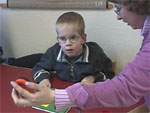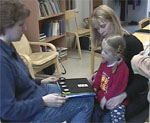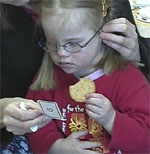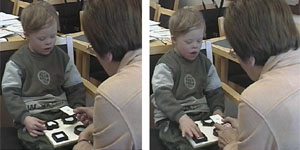Training before vision testing
Measurement of visual acuity with symbol tests requires ability either to match forms or to have names for the symbols as words or signs. The concept of pictures representing objects can be trained and the tester can learn to adjust communication to fit the communication technique and level of the child.
For training the concepts similar -different related to the test symbols there is the LEA Puzzle that can be used from early on. Names and signs can be trained as part of play situations in day care and at home using concrete objects and pictures. Since the concept of pictures representing objects is often difficult to visually impaired children with developmental delays, training of picture perception and comprehension should be an integral part of early intervention. Pictures should not be used in communication before the child is known to perceive and comprehend them.
Getting to know the LEA test symbols
 If a child has not seen the test symbols ever before, it is often wise to introduce them by playing with the LEA Puzzle. It is designed to help the child in creating the concepts similar and different first in terms of colours and then of black-and-white forms. During the play situation the child may need a lot of time to explore all details of the forms and the cut-outs. See the video.
If a child has not seen the test symbols ever before, it is often wise to introduce them by playing with the LEA Puzzle. It is designed to help the child in creating the concepts similar and different first in terms of colours and then of black-and-white forms. During the play situation the child may need a lot of time to explore all details of the forms and the cut-outs. See the video.
Comparing the puzzle pieces and small pictures
 1. When the child is accustomed to play with the puzzle, it is time to start working with the next big step, picture perception. To understand and believe that a two-dimensional picture has the same name as the puzzle piece may take a few days or a few months. We usually start by drawing around the puzzle pieces to demontrate the relationship between the concrete object and its picture. At the same time we draw around a number of other things, the child's hands and feet, shoes, plate, spoon etc. to give a wider range of experiences with objects and their pictures.
When the child has learned to place the puzzle pieces on their large pictures, we draw slightly smaller pictures and decide with the child that they as well can have the same names as the big ones. At this time we start using the LEA Playing Cards and assess for the first time visual acuity with single symbols at near.
When the child is accustomed to play with the cards during therapies and/or in the play situations of the day care centre, (s)he may be interested to play quite some time. This play situation reveals how well the child understand spoken language or sign language. Note that at the end of the video sequence the child signs "good" to show how well she has been working. We started with the largest (16M) pictures of the LEA Playing Cards. See the video.
1. When the child is accustomed to play with the puzzle, it is time to start working with the next big step, picture perception. To understand and believe that a two-dimensional picture has the same name as the puzzle piece may take a few days or a few months. We usually start by drawing around the puzzle pieces to demontrate the relationship between the concrete object and its picture. At the same time we draw around a number of other things, the child's hands and feet, shoes, plate, spoon etc. to give a wider range of experiences with objects and their pictures.
When the child has learned to place the puzzle pieces on their large pictures, we draw slightly smaller pictures and decide with the child that they as well can have the same names as the big ones. At this time we start using the LEA Playing Cards and assess for the first time visual acuity with single symbols at near.
When the child is accustomed to play with the cards during therapies and/or in the play situations of the day care centre, (s)he may be interested to play quite some time. This play situation reveals how well the child understand spoken language or sign language. Note that at the end of the video sequence the child signs "good" to show how well she has been working. We started with the largest (16M) pictures of the LEA Playing Cards. See the video.
2. When the pictures get smaller and smaller, the child very clearly expresses her difficulty in seeing. At this point the size of the pictures is only 6.3M and the girl saw it at a distance of 40cm, Visual acuity is thus 0.4n/6.3M = 0.06 (or 6/100, 20/333, if these near vision acuities are incorrectly expressed as distance acuity values). See the video.
|
When an eye is coved with a patch, the child may react very negatively. Small scale bribing is acceptable to calm the child so much that training or testing can be continued. In this situation we learn what is the child's near vision acuity with single symbols. See the video. |

|
Comparing small pictures and the puzzle pieces
1. Matching the puzzle pieces with small pictures can be trained also this way: the child is shown the cards one by one and the child responds by touching the corresponding puzzle piece or cut-out. When the response pictures are large and their location is well known the child does not need to look at them very carefully but can concentrate on focusing on the small pictures. See the video.
2. When the child is accustomed to measurements using single symbols, we can start training with the line tests. To move the gaze from one symbol to the next is difficult, the movement often is too long, the child skips one symbol. It is wise, not to disturb the child at that point but ask the child "What is then next to that picture?" If the child reads the next symbol correctly and then goes on to the end of the line, ask the child "What did to say this picture was?" and briefly point to the symbol that was not read.
In a true line test situation one does not leave a finger or a pencil pointing at the symbol because it may make the fixation much easier for an amblyopic child or a child with brain damage related vision impairment. If in the beginning of training one has to point on the symbols, it should be documented in the diary. The standard near vision test can be used in the assessment of children at early communication levels by holding a white card above the line to be read. This technique reduces the crowding from above.
Before testing vision the tester should have information on the refractive error of the child and the structure of the eyes and visual pathways. Measurement of refractive error does not take much time if the child can hold fixation on the retinoscope of the doctor as shown in the video sequences below. Accommodation capacity needs to be measured before the drops are used so that it is known whether the child can adjust accommodation so that the image is sharply focused on the retina. Often measurement of both accommodation and refraction, as well as examination of the eyes takes time and requires quick movements of the doctor to compensate for the movements of the child. Sometimes these important basic examinations of refraction and anatomy of the eyes are possible only under sedation of the child. Accommodation must be assessed with cooperation of the child because it requires that the child is interested to focus at the accommodative small target next to the retinoscope.
Signs as response
Some children prefer using signs instead of the puzzle. Which signs will be used needs to be agreed upon before training or testing. See the video.
"House" is often easy to recognize as well as "apple", but "ball" often looks more like "book" and "window" often is such a swift movement that one hardly recognizes it. The tester asks “What picture is the first on this line” and points at the line, not at the optotype. See the video.
When the child is accustomed to have a patch, monocular visual acuity values can be measured. See the video.
